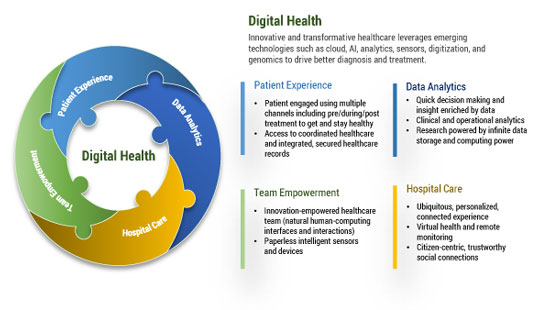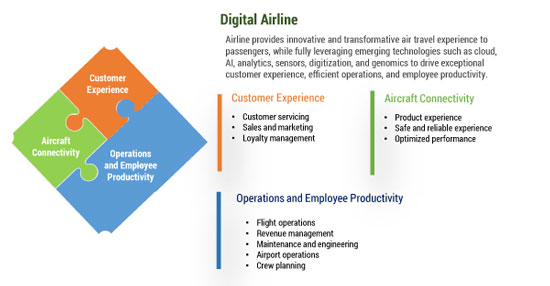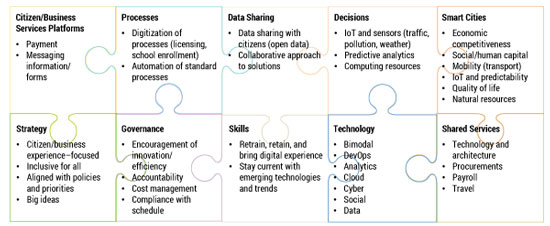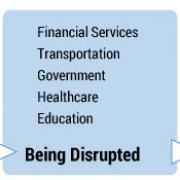According to industry analysts, 67% of Global 2000 enterprises “will have digital transformation at the center of their corporate strategy” by 2018. Companies like Uber, Netflix, Amazon, Spotify, Coursera, and PayPal started as digital businesses and have digital in their DNA. Many established businesses like Mercedes-Benz, American Airlines, GE, JPMorgan Chase, Boeing, and Walt Disney have made digital transformation a central focus of their business strategy and are reaping the benefits from it. Many other businesses are either in the early stages of this digital transformation or face the risk of becoming obsolete.
Sooner or later, all industries will be impacted by digital disruption. In fact, digital business has invented new industries that did not exist before. Figure 1 provides a quick overview of various industries and their current status in terms of digital disruption.

Figure 1 — Industries being impacted by digital disruption.
Even though being disrupted will be difficult on laggards, it does not mean that an industry is dead. It only means that the industry is reinventing itself, and surviving in this environment will require businesses to adapt to the changes quickly. For example, even though many long-standing daily newspapers have withered or died, newspapers like the Washington Post have reinvested in themselves and are beginning to thrive. Depending on the industry, changes may involve new business offerings, new partnership or compensation models, more efficient operations to attract new clients, or improved underlying technologies and infrastructure. For example, within manufacturing, 3D printing may be used to create custom-made parts faster and at a reduced cost. In the following sections, I review three business areas — digital health, digital airline, and digital government — and discuss the currrent state of each industry, key challenges, and the digital disruption taking place. I also show how innovators are converting these challenges into business opportunities and delivering innovative solutions for the benefit of society.
Digital Health
The healthcare industry is under tremendous pressure to deliver higher-quality care at lower cost. Lack of sufficient health insurance, ineffective government policies, and hard-to-access health record data lead to delayed treatment of diseases, increased complexity, and higher cost of treatment. A shortage of skilled healthcare professionals, the emergence of new diseases, and changing expectations from patients make it still more difficult. Going digital is one key to reducing cost by streamlining organizational processes, analyzing the clinical data needed to make better healthcare decisions, and offering better health management tools to caregivers and consumers.
Scores of health providers, both startups and established players, are trying new approaches that use emerging technologies to deliver healthcare services more effectively, often with a focus on prevention, wellness, and managing chronic conditions. Innovators and early adopters of digital health are relying on emerging technologies (cloud, AI, analytics, social, cyber), reengineering patient experience and operations (comprehensive patient engagement, personalized medicine, coordinated care, and record keeping), and focusing on delivering innovative solutions to earn a share of the trillions of dollars in annual healthcare spending. Figure 2 provides details on some of the key capabilities required to achieve the full benefit of digital healthcare.

Figure 2 — Essentials for digital health.
Forward, a medical startup just launched by serial entrepreneur Adrian Aoun, provides access to futuristic primary care for US $149 a month. There are no copays, and membership — as with Netflix — covers an all-you-can-consume set of services from the practice: doctor visits, a baseline screening, access to Forward’s team of doctors and nurses via email, ongoing monitoring through wearable devices, and even some medications and supplements. You’ll still need to buy insurance to cover things like hospitalizations, surgeries, and specialist care, but Forward takes care of basic healthcare at a much more reasonable cost.
Digital Airline
Over the past couple of decades, the airline industry has gone through a lot — terrorism, which resulted in increased security requirements and cost; global financial instability, which led to fluctuating travel demand; and higher fuel prices, which impacted the bottom line. Ever-increasing competition from global and regional airlines and travelers’ demands for better customer experience have forced airlines to develop new business models, optimize business operations, and fully leverage emerging technologies effectively.
Digital disruption is impacting all core capabilities of the airline industry, including sales, route scheduling, customer service, seat occupancy, loyalty programs, and more. Airlines that have not been able to change with the times have either been acquired by other airlines or gone out of business. Most airlines that are undergoing digital transformation are focusing on three areas (see Figure 3):
- Customer experience
- Operations and employee productivity
- Aircraft connectivity

Figure 3 — Essentials for a digital airline.
Customer Experience
Customer experience includes collecting and understanding customer behaviors and providing offers and experiences that are personal, relevant, and connected across all journey touchpoints, thus promoting customer loyalty and workforce productivity. Let us review a couple of these touchpoints:
- Digital airport — provides a seamless transition from arrival at the airport to ticketing to boarding, and then from landing to baggage claim to departure from the airport with personalized and location-aware mobile devices
- Multichannel commerce — focuses on delivering the right product to the right customer in the right place at the right time
Most successful airlines have been focusing on customer experience, and based on an industry poll, JetBlue and Southwest have emerged as the top scoring airlines in this category.
Operations and Employee Productivity
This area includes providing passengers with exceptional integrated services while improving operational efficiencies and capturing critical data in time to provide rich insight. Operational efficiencies include things like efficient flight, ground, and airport operations:
- Flight operations — requires effective communication among crew and maintenance crew to deliver excellent passenger services and resolve issues in time; enables easy access to crew schedule, flight manuals
- Ground operations — enables improved aircraft maintenance and safety through collaboration; quick identification and resolution of any maintenance issues
- Airport operations — leverages in-air and on-ground data and analytics to drive efficiency and resolve any airport operational issues by communicating with experts
Aircraft Connectivity
Seamless connectivity between aircraft, staff, passengers, and processes enables a friction-free passenger journey. It ensures optimal product experience and performance, including onboard comforts and conveniences provided through optimized crew and flight operations.
Digital Government
As private businesses across different industries are transforming themselves with digital technologies, citizens across the globe are calling on their respective governments to follow suit. Even though effecting any change, including digital transformation, tends to be more challenging within the public sector than the private sector, government leaders at all levels are listening to citizens and realizing that they need to transform how government is working today. They are looking for ways to improve the public’s experience with government at the federal, state, local, agency, and department levels and supporting initiatives to build, buy, and share technology that allows for efficient services for citizens and businesses. Constrained budgets and increased expectations from citizens are encouraging the use of emerging digital technologies to reengineer and streamline business processes and operations to deliver services focused on customer experience.
Irrespective of size, the digitizing of any agency is complex and requires special attention to core capabilities for engaging citizens, other agencies, and private businesses. Leading business strategy consulting firms suggest that when done successfully, worldwide government digitization can save $1 trillion annually in economic value. Figure 4 provides a high-level overview of various capabilities a successful digital government must have, as well as some of the critical elements (e.g., strategy, governance) that enable them.

Figure 4 — Essentials for digital government.
Most governments across the globe realize the complexity and criticality of transforming themselves, but they also see the potential benefits of doing so. Examples of digital transformation at the federal and municipal levels include:
- The US General Services Administration (GSA) created 18F (now part of the GSA’s Technology Transformation Service [TTS]) and the White House launched the US Digital Service (USDS) to focus on fostering digital transformation by helping agency leaders understand and implement new approaches, business models, and technologies.
- Striving to become “The Smartest City” in the world, “Singapore is using data to redefine what it means to be a 21st-century metropolis.”
- In India’s Smart Cities Mission, the Ministry of Urban Development has identified 60 cities to be developed as smart cities and “use technology, information, and data to improve infrastructure and services.... [to] improve quality of life, create employment, and enhance incomes for all.”
Digitization helps governments make their services more accessible, efficient, and effective.
[For more from the author on this topic, see “Disrupt or Be Disrupted: The Digital Business Imperative.”]



